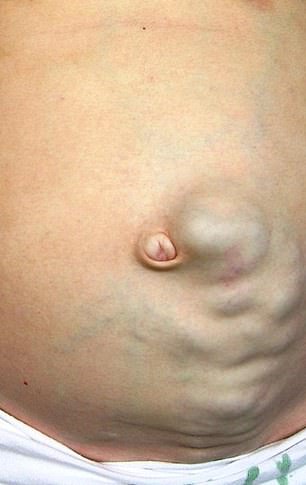What your BELLY BUTTON reveals about your health, according to experts
Most of us probably don’t think about our belly button.
However, experts suggest that this small fold of skin can be a host to infections, cysts and even hernias.
Dr. Dan Baumgardt, a neuroscientist and physiologist at the University of Bristol in Britain, prescribed The conversation that the belly button – known medically as the belly button – “has more depth than just a few millimeters.”
The navel is a remnant of the umbilical cord, which connects a fetus to its mother during pregnancy. There are many variations, but the two main groups are ‘outies’ and ‘innies’.
About 10 percent of people around the world have an outie, meaning their belly button sticks out, while the rest have an innie.
Most people have an ‘innie’, belly button, which means the skin flap folds inward instead of protruding outward
Although the belly button no longer has a function after birth, subtle changes in the way it appears can be an indication that something is wrong with our health.
One of these, Dr. Baumgardt notes, is an umbilical hernia, which occurs when part of the intestine bulges through the belly button. This causes swelling or a bulge from the belly button.
These are usually harmless and mainly affect babies, although they are also the second most common hernia in adults. Being overweight or having multiple pregnancies can increase the risk of adults developing an umbilical hernia.
Usually no treatment is needed, although the hernia may need to be surgically removed if it is causing pain or blocking the intestine.
Dr. Baumgardt also pointed out a rare complication called Sister Mary Joseph’s nodule, named after a nun who discovered that many patients with advanced cancer had swelling or a lump near their belly button.
This may be a sign that the patient’s cancer has spread or become more advanced.
“It is not seen as often these days because more cancers are now diagnosed earlier before extensive spread,” writes Dr. Baumgardt.
Another unusual condition of caput medusae, or Medusa’s head.
Also called a palm tree sign, this is a network of painless, swollen veins around the belly button. From a distance it also looks like a black or blue bruise.
This is caused by portal hypertension, high pressure in the portal vein. The portal vein transported blood from the intestines, gallbladder, pancreas and spleen to the liver. The liver then processes nutrients in the blood and sends them to the heart.


Medusa’s head (left) and Sister Mary Joseph’s lump (right) are two rare conditions that form in or around the navel
Medusa’s head in itself is not a disease, although it is usually a sign of liver scarring, also called cirrhosis.
The scarring makes it more difficult for blood to flow through the veins of the liver, causing it to pool in the portal vein and flow to nearby veins near the belly button.
This enlarges those blood vessels into a Medusa-like pattern.
The belly button can also harbor infections, especially if you have an innie.
This fold can trap moisture and dirt, and warm environments like these are the ideal environment for bacteria to grow.
Signs of an infection in the belly button include redness, pain, swelling, foul odor, and oozing of pus or other fluids.
